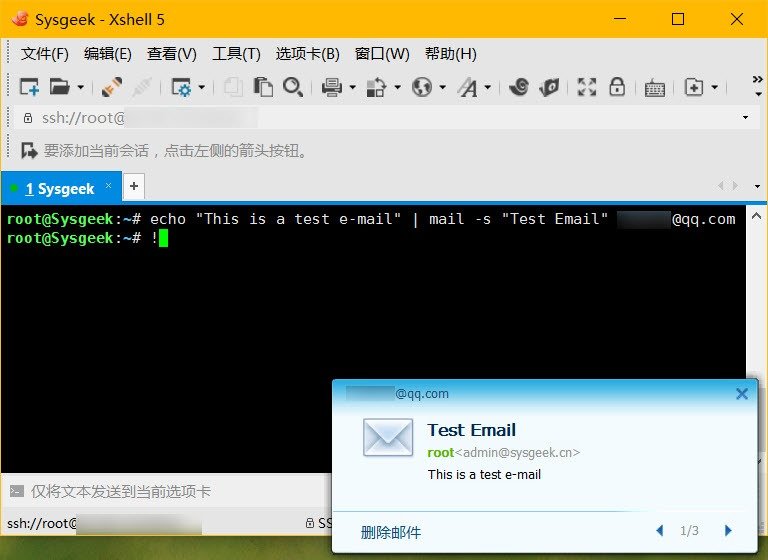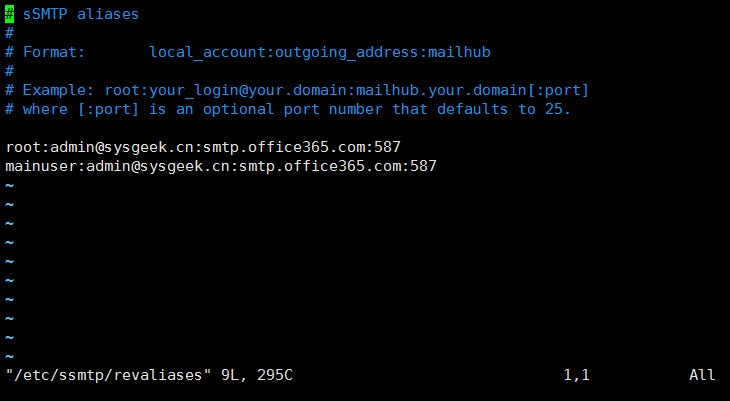SSMTP—Let Linux systems send emails from Office 365
SSMTP is a very simple and practical little tool that can relay emails from Linux systems to Office 365, Google or other third-party SMTP servers. SSMTP is not a mature and complete email server. It can only automatically submit emails to other SMTP servers such as Google, Tencent, 163, and Office 365. In this article, we'll cover how to configure SSMTP to send email through an Office 365 account.

How SSMTP works
Before the formal installation and configuration, let's briefly introduce how SSMTP works. SSMTP can be installed on any Linux system. Once configured, all emails sent from root, nobody or other applications can be forwarded through SSMTP. We can also configure emails from PHP, Python, Ruby and other applications to be forwarded using this program. In short, you can think of SSMTP as Mailhub in Linux.
In Mailhub, you can configure and specify the Gmail SMTP server or Microsoft Office365 SMTP server address. Once the server and email address are specified for it, it can send emails directly through the cloud service.
Install SSMTP
SSMTP installation is very simple and is available in many Linux sources. RHEL-based Linux distributions (RHEL/CentOS/Fedora) can be installed using the following command:
yum install ssmtp
Ubuntu and Debian servers can be installed using the following command:
sudo apt-get install ssmtp
After the installation is completed, all configuration files will be written to the /etc/ssmtp/ directory.
Use SSMTP instead of sendmail/postfix
Generally, many Linux distributions use Sendmail or Postfix as the default email system. The reason why we use SSMTP is to use the external SMTP relay. Therefore, to configure SSMTP as the system default, we must first disable it. sendmail or postfix service.
systemctl stop sendmail systemctl stop postfix
If you are using an earlier version of Linux, you can use the following command to disable the service:
service sendmail stop service postfix stop
Note: You also need to stop the sendmail or postfix service when it starts up with the system. It is best to uninstall it directly.
Configure SSMTP to use Office365 email address
Use vim or any editor you like to edit the /etc/ssmtp/ssmtp.conf file. We take the SMTP server of Office 365 as an example. If you use other SMTP, please modify it according to the official documentation of the service provider. :
root=admin@sysgeek.cn mailhub=smtp.office365.com:587 AuthUser=admin@sysgeek.cn AuthPass=XXXXX UseTLS=YES UseSTARTTLS=YES FromLineOverride=YES RewriteDomain:sysgeek.cn

After the configuration file is modified and saved, we can use the reliable email service provided by Office 365. Now use the following command to send a test email to see:
echo "This is a test e-mail" | mail -s "Test Email" XXXX@qq.com

If you encounter a prompt similar to the following when sending a test email:
ssmtp: Cannot open mail.server.com:25
That’s because ssmtp will try to use the standard SMTP port 25 to connect to the mail server by default. If the SMTP relay you use uses a non-standard port with TLS encryption like Gmail or Office 365, you also need to go to /etc/ The sender, server address and port are specified in the ssmtp/revaliases configuration file: 
The above is the detailed content of SSMTP—Let Linux systems send emails from Office 365. For more information, please follow other related articles on the PHP Chinese website!

Hot AI Tools

Undresser.AI Undress
AI-powered app for creating realistic nude photos

AI Clothes Remover
Online AI tool for removing clothes from photos.

Undress AI Tool
Undress images for free

Clothoff.io
AI clothes remover

Video Face Swap
Swap faces in any video effortlessly with our completely free AI face swap tool!

Hot Article

Hot Tools

Notepad++7.3.1
Easy-to-use and free code editor

SublimeText3 Chinese version
Chinese version, very easy to use

Zend Studio 13.0.1
Powerful PHP integrated development environment

Dreamweaver CS6
Visual web development tools

SublimeText3 Mac version
God-level code editing software (SublimeText3)

Hot Topics
 1386
1386
 52
52
 How to use docker desktop
Apr 15, 2025 am 11:45 AM
How to use docker desktop
Apr 15, 2025 am 11:45 AM
How to use Docker Desktop? Docker Desktop is a tool for running Docker containers on local machines. The steps to use include: 1. Install Docker Desktop; 2. Start Docker Desktop; 3. Create Docker image (using Dockerfile); 4. Build Docker image (using docker build); 5. Run Docker container (using docker run).
 Difference between centos and ubuntu
Apr 14, 2025 pm 09:09 PM
Difference between centos and ubuntu
Apr 14, 2025 pm 09:09 PM
The key differences between CentOS and Ubuntu are: origin (CentOS originates from Red Hat, for enterprises; Ubuntu originates from Debian, for individuals), package management (CentOS uses yum, focusing on stability; Ubuntu uses apt, for high update frequency), support cycle (CentOS provides 10 years of support, Ubuntu provides 5 years of LTS support), community support (CentOS focuses on stability, Ubuntu provides a wide range of tutorials and documents), uses (CentOS is biased towards servers, Ubuntu is suitable for servers and desktops), other differences include installation simplicity (CentOS is thin)
 What to do if the docker image fails
Apr 15, 2025 am 11:21 AM
What to do if the docker image fails
Apr 15, 2025 am 11:21 AM
Troubleshooting steps for failed Docker image build: Check Dockerfile syntax and dependency version. Check if the build context contains the required source code and dependencies. View the build log for error details. Use the --target option to build a hierarchical phase to identify failure points. Make sure to use the latest version of Docker engine. Build the image with --t [image-name]:debug mode to debug the problem. Check disk space and make sure it is sufficient. Disable SELinux to prevent interference with the build process. Ask community platforms for help, provide Dockerfiles and build log descriptions for more specific suggestions.
 How to view the docker process
Apr 15, 2025 am 11:48 AM
How to view the docker process
Apr 15, 2025 am 11:48 AM
Docker process viewing method: 1. Docker CLI command: docker ps; 2. Systemd CLI command: systemctl status docker; 3. Docker Compose CLI command: docker-compose ps; 4. Process Explorer (Windows); 5. /proc directory (Linux).
 What computer configuration is required for vscode
Apr 15, 2025 pm 09:48 PM
What computer configuration is required for vscode
Apr 15, 2025 pm 09:48 PM
VS Code system requirements: Operating system: Windows 10 and above, macOS 10.12 and above, Linux distribution processor: minimum 1.6 GHz, recommended 2.0 GHz and above memory: minimum 512 MB, recommended 4 GB and above storage space: minimum 250 MB, recommended 1 GB and above other requirements: stable network connection, Xorg/Wayland (Linux)
 Detailed explanation of docker principle
Apr 14, 2025 pm 11:57 PM
Detailed explanation of docker principle
Apr 14, 2025 pm 11:57 PM
Docker uses Linux kernel features to provide an efficient and isolated application running environment. Its working principle is as follows: 1. The mirror is used as a read-only template, which contains everything you need to run the application; 2. The Union File System (UnionFS) stacks multiple file systems, only storing the differences, saving space and speeding up; 3. The daemon manages the mirrors and containers, and the client uses them for interaction; 4. Namespaces and cgroups implement container isolation and resource limitations; 5. Multiple network modes support container interconnection. Only by understanding these core concepts can you better utilize Docker.
 What is vscode What is vscode for?
Apr 15, 2025 pm 06:45 PM
What is vscode What is vscode for?
Apr 15, 2025 pm 06:45 PM
VS Code is the full name Visual Studio Code, which is a free and open source cross-platform code editor and development environment developed by Microsoft. It supports a wide range of programming languages and provides syntax highlighting, code automatic completion, code snippets and smart prompts to improve development efficiency. Through a rich extension ecosystem, users can add extensions to specific needs and languages, such as debuggers, code formatting tools, and Git integrations. VS Code also includes an intuitive debugger that helps quickly find and resolve bugs in your code.
 vscode cannot install extension
Apr 15, 2025 pm 07:18 PM
vscode cannot install extension
Apr 15, 2025 pm 07:18 PM
The reasons for the installation of VS Code extensions may be: network instability, insufficient permissions, system compatibility issues, VS Code version is too old, antivirus software or firewall interference. By checking network connections, permissions, log files, updating VS Code, disabling security software, and restarting VS Code or computers, you can gradually troubleshoot and resolve issues.




